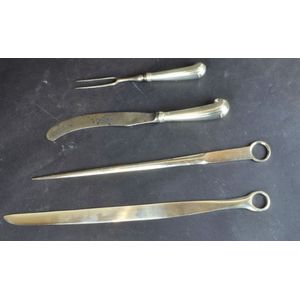Antique Flatware Serving Pieces, Georgian and Silver Handles
You must be a subscriber, and be logged in to view price and dealer details.
Subscribe Now to view actual auction price for this item
When you subscribe, you have the option of setting the currency in which to display prices to $Au, $US, $NZ or Stg.
- Flatware - An alternative name for items of cutlery, principally knives, forks and spoons, now generally used to describe sets of these implements. Nowadays it is mostly used when describing cutlery made of silver and silver plate.
It is less frequently used to describe all "flat' items of tableware, so that as well as cutlery the definition includes plates. - Georgian - As an English stylistic period, Georgian is usually taken to cover the period from George I (1714) to the Regency of Prince George (1811-20), although the period from 1800 to 1830 is sometimes designated as the Regency period. During the Georgian period the great English cabinetmakers and designers such as Chippendale, Hepplewhite, Adam Sheraton etc., were all active.
Therefore there isn't a single 'Georgian style' as such and to say something is 'Georgian', usually means it was made between 1714 and 1830. This assumes we discount George V and George VI, both being from the 20th century.
The styles popular at the time of each reign were:
George I (1714-1727) saw out the last years of the Baroque period.
George II (1727-1760) reigned during the Rococo period.
George III (1760-1820) saw the last gasp of the Rococo, all of the early Neo-Classic 'Adam style' and most of the later neo-Classic 'Regency style'.
George IV (Prince Regent 1820-1830)encompassed the last of the 'Regency' style.
William IV's reign (1830-1837) was something of a no man's land (stylistically) and he wasn't a 'George' anyway. He covered the last glimmerings of 'Regency' and the start of the 'Victorian' style.
This item has been included into following indexes:
Visually similar items

Four various sterling silver sugar tongs 1. Plain form, Sheffield 1918. 2. Claw form bowls, 1939 3. Decorative, Birmingham 1906. 4. Sheffield 1922, Henry Williamson

Sterling silver 4 piece manicure set in the form of golf clubs, stamped Sterling

Two pairs of sugar tongs: Georgian sterling silver and German .800, 1811 London with maker's mark for Thomas Barker, and post 1886 Germany, a fiddle pattern pair and the German pair with fanned ribs in the manner of Onslow design, gilt washed to the interi

Two pairs of sterling silver sugar tongs, 1810 London with maker's marks for probably Thomas Shekelton, and the other marked Germany, 925 sterling silver, the simple unadorned pair, one with pointed bowls, the other with swollen cushion profile arms and ov
